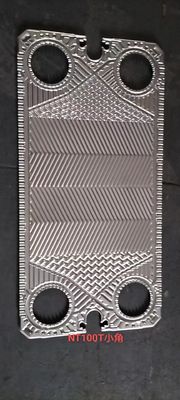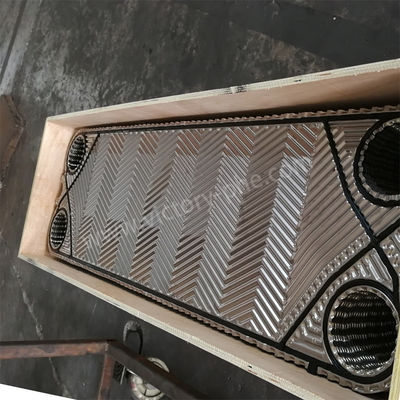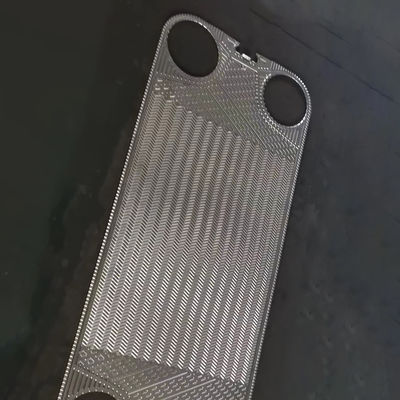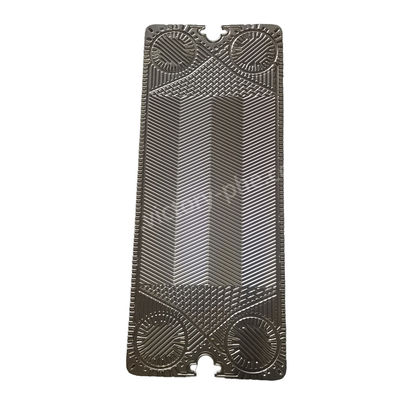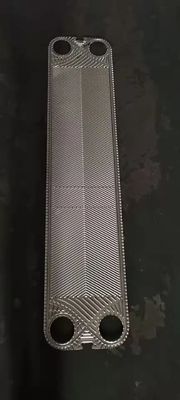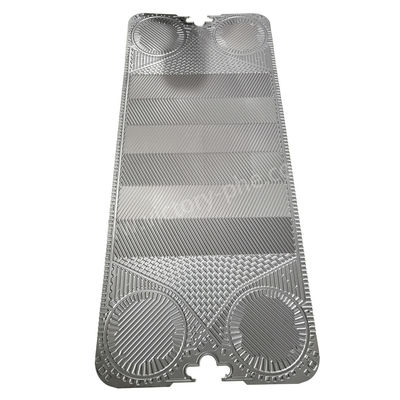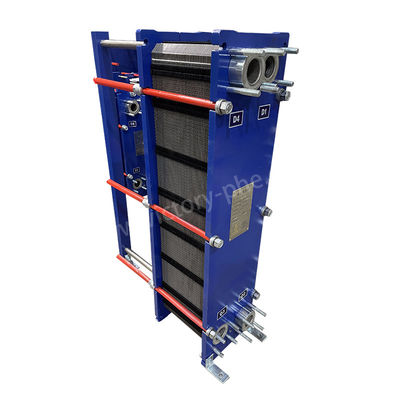PRODUCT DESCRIPTION
Stainless Steel Water Treatment Plate Heat Exchanger For Industrial Cooling
Plate Heat Exchangers
A plate heat exchanger comprises a series of metal plates stacked together, each with specific corrugations. These plates create narrow rectangular channels, facilitating heat exchange between fluids, particularly in liquid-to-liquid and liquid-to-vapor operations.
Plate heat exchangers offer several advantages: exceptional heat transfer efficiency, minimal thermal losses, compact and lightweight design, small footprint, versatility, and long service life. Compared to traditional tube heat exchangers, they achieve higher heat transfer coefficients while occupying less space. Additionally, they can achieve heat recovery rates exceeding 90%.
The unique design of plate heat exchangers promotes efficient heat transfer while minimizing pressure drop. The corrugated plates induce turbulence in fluid flow, enhancing heat transfer capabilities. Consequently, plate heat exchangers are widely preferred in industries for heating, cooling, and heat recovery processes.
|
Model
|
DLXU03/DLXM3
|
|
Plate Thickness
|
0.5/0.6mm
|
|
Plate Hole Size
|
50mm
|
|
Maximum Throughput
|
45m3/h
|
|
Adapter Pipe For Large-diameter
|
DN50
|
|
Working Pressure
|
1.0/1.6MPa
|
|
Test Pressure
|
1.3/2.1Mpa
|
|
Model
|
Standard maximum flow rate
m3/h
|
Maximum number of assembled pieces
N
|
Clamping size
A
|
Maximum length
L1
|
|
VH05
|
45
|
167
|
N*(300+X)
|
1390
|
|
VN5
|
45
|
211
|
N*(2.0+X)
|
1390
|
According to the structure, plate heat exchangers can be classified into four main types:
Gasketed Plate Heat Exchangers, also known as removable plate heat exchangers, consist of detachable metal plates sealed with gaskets, making them suitable for applications with lower flow rates and significant temperature variations.
Welded Plate Heat Exchangers feature metal plates welded directly together to form a tightly sealed heat transfer surface, making them ideal for high-pressure and high-temperature environments.
Spiral Plate Heat Exchangers utilize a pair of spiral-shaped metal plates to create multiple channels for fluid separation and heat exchange.
Plate and Frame Heat Exchangers, or honeycomb heat exchangers, consist of corrugated metal plates stacked within a frame. Fluid flows through alternating channels between the plates, enabling efficient heat transfer.
| Product parameter of gasketed plate heat exchanger |
| Item |
plate heat exchanger |
| Brand |
Victory |
| Plate material |
Titanium/Nickle/hastolly/Stainless steel 0.5mm 0.6mm 0.7mm 0.8mm 1mm |
| Gasket material |
NBR HNBR EPDM HEPDM VITON FKM Silicone |
| Frame material |
Painted Carbon steel |
| Color of frame |
blue or customed color |
| Connection type |
flange or thread |
| Flange standard |
ANSI ASME BS BA JIS DIN GB ISO |
| Tightening bolt |
M24 M30 M39 |
| Design pressure |
highest 20mpa, lowest 10Mpa |
| Work pressure |
normal 12.5Mpa |
| MOQ |
1 set |
| Package |
polywood case |
| Warranty |
one year |
| OEM |
Can make replacement |


|
Plate Material
|
Suitable Fluid
|
|
Stainless steel (SUS304, 316L etc.)
|
Pure water, River water, Edible salt water, Mineral oil
|
|
Titanium, Ti-pd
|
Brine, sea water, Salt water
|
|
SMO254
|
Dilute sulphuric acid, Salt water solution, Inorganic aqueous solution
|
|
Ni
|
High temperature, High concentration of caustic soda
|
|
Hastelloy (C276, C22)
|
Concentrated sulfuric acid, Hydrochloric acid, Phosphoric acid
|
|
Main Body Gasket
|
Operating Temperature (℃)
|
Suitable Fluid
|
|
NBR
|
-15 ~ +135
|
Water, Sea water, Mineral Salt, Brine
|
|
EPDM
|
-25 ~ +180
|
Hot water, Vapour, Acid, Base
|
|
F26
|
-25 ~ +230
|
Acid, Base, Fluid
|
|
FTP
|
0 ~ +160
|
Concentrated acid, Base, High temperature oil, Vapour
|
Plate heat exchangers applications:
Solar Energy: Plate heat exchangers play a crucial role in efficiently harnessing solar energy through collectors, where they facilitate the transfer of heat between the solar fluid and the working fluid, ensuring optimal energy conversion.
Chemical Industry: Plate heat exchangers are integral components in various chemical processes, including heat recovery, product cooling, and reaction temperature control, ensuring efficient and precise operation of chemical reactors and distillation units.
Steel Industry: In the steel industry, plate heat exchangers are essential for cooling and lubricating critical equipment such as rolling mills, blast furnaces, and quenching tanks, contributing to maintaining optimal operating temperatures and extending equipment lifespan.
Metallurgical Industry: Plate heat exchangers are employed in the metallurgical industry for heating and cooling processes involved in aluminum refining, ensuring precise temperature control and efficient energy utilization throughout the production cycle.
Machinery Manufacturing: Plate heat exchangers are utilized in machinery manufacturing for cooling quenching liquids and lubricants in various industrial equipment, ensuring consistent performance and prolonging machinery life.
Food Industry: Plate heat exchangers play a vital role in the food industry, facilitating sterilization, pasteurization, and cooling processes in food processing plants, ensuring product safety, quality, and shelf-life extension.
Textile Industry: Plate heat exchangers contribute to heat recovery and cooling processes in textile manufacturing, optimizing energy efficiency and reducing environmental impact by recycling waste heat from processes such as dyeing and finishing.
Paper Industry: Plate heat exchangers are essential in the paper industry for cooling and heat recovery applications, ensuring efficient operation of paper machines, drying cylinders, and wastewater treatment systems while minimizing energy consumption and environmental footprint.
District Heating: Plate heat exchangers are utilized in district heating systems to transfer heat from power plant waste heat areas to residential and commercial buildings, providing efficient and sustainable heating solutions for urban communities.
Oil and Fat Industry: Plate heat exchangers are employed in the oil and fat industry for heating and cooling applications in oil processing plants, ensuring precise temperature control during refining, fractionation, and packaging processes.
Power Industry: Plate heat exchangers play a crucial role in power plants for cooling systems, including condensers, turbine lubrication, and auxiliary equipment cooling, ensuring efficient and reliable operation of power generation facilities.
Marine Applications: Plate heat exchangers are utilized in marine vessels for cooling systems, including diesel engines, central coolers, and seawater desalination systems, ensuring reliable performance and efficient operation in maritime environments.
Seawater Aquaculture: Plate heat exchangers contribute to heating seawater in hatcheries for aquaculture applications, providing optimal water temperatures for fish and shellfish cultivation, promoting growth and enhancing overall production efficiency.
Other Industries: Plate heat exchangers find extensive use in pharmaceutical, petroleum, ceramic, glass, cement, and geothermal applications, contributing to efficient heat transfer, process optimization, and environmental sustainability across diverse industrial sectors.

 Your message must be between 20-3,000 characters!
Your message must be between 20-3,000 characters! Please check your E-mail!
Please check your E-mail!  Your message must be between 20-3,000 characters!
Your message must be between 20-3,000 characters! Please check your E-mail!
Please check your E-mail! 
